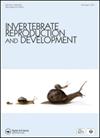Reproductive biology of the freshwater crab Goyazana castelnaui (Brachyura: Trichodactylidae) in a semiarid region of Brazil
IF 0.8
4区 生物学
Q4 REPRODUCTIVE BIOLOGY
引用次数: 4
Abstract
ABSTRACT The reproductive pattern of Goyazana castelnaui is described based on the variation of gonadal maturation stages and secondary sexual characteristics. We analyzed 89 specimens from the Pajeú River in the semiarid region of Brazil from September 2014 to August 2015. The average sex ratio was 1F: 0.5M. The carapace width (CW) and weight of females ranged from 1.18 to 4.97 cm and 1.76 to 37.46 g. Male carapace width and weight were between 1.05 and 4.34 cm and 1.11 to 39.71 g. Goyazana castelnaui had a seasonal reproductive cycle that was more active between September and December. Gonad maturation was before the pubertal moult. The spawning season began in August when temperature increased, and ended in February. The onset of the rainy season (November) is thought to be the trigger for a decline in spawning. The gonads of females and males became mature at the same CW50 (2.84 cm). This size is smaller than the morphometric maturation size: 3.85 cm CW in females and 3.65 cm CW in males. This first contribution to the reproductive biology of G. castelnaui should be a basis for further research on its reproduction, especially in other areas of its distribution. Abbreviations: AM: adult male; AF: adult female; °C: Celsius degree; cm: centimeters; Cw: carapace width; CNPq: Brazilian National Council for Scientific and Technological Development; F: female; FC: folicular cells; g: grams; h: hour; INPE: National Institute of Space Research; JF: juvenile female; JM: juvenile male; M: male; MO: mature oocytes; mm: millimeters; µm: micrometer; OO: oogonia; PCA: Principal Component Analysis; PE: Pernambuco; PRPPG: Pro-Rectory of Research and Post-Graduate; PSW: pleon segment width; PVO: pre-vitellogenic oocytes; PVD: posterior vas deferens; RCL: right chela length; RC: ruptured cells; SM: spermatophoric matrix; SP: Spermatophores S: south; Tw: Total weight; UFRPE: Federal Rural University of Pernambuco; VO: vitelogenic oocytes; W: west;巴西半干旱区淡水蟹Goyazana castelnaui(腕足目:毛足蟹科)的生殖生物学
摘要基于性腺成熟阶段和第二性征的变化,描述了沙蚕的生殖模式。我们分析了2014年9月至2015年8月巴西半干旱区Pajeú河的89个标本。平均性别比为1F: 0.5M。雌虫甲壳宽度(CW)为1.18 ~ 4.97 cm,体重为1.76 ~ 37.46 g。雄甲壳宽1.05 ~ 4.34 cm,重1.11 ~ 39.71 g。Goyazana castelnaui有一个季节性的繁殖周期,在9月到12月之间更为活跃。性腺成熟发生在青春期蜕皮之前。产卵季节从气温升高的8月开始,到2月结束。雨季(11月)的开始被认为是产卵减少的诱因。雌雄生殖腺在同一CW50 (2.84 cm)成熟。这个尺寸小于形态学成熟尺寸:雌性3.85 cm CW和雄性3.65 cm CW。这一研究成果将为进一步研究其生殖生物学,特别是在其他分布地区的生殖生物学研究奠定基础。缩写:AM:成年男性;AF:成年女性;°C:摄氏度;cm:厘米;Cw:外壳宽度;巴西国家科学和技术发展委员会;F:女性;FC:滤泡细胞;g:克;h:小时;INPE:国家空间研究所;JF:幼雌;JM:少年雄性;M:男性;MO:成熟卵母细胞;mm:毫米;µm:千分尺;面向对象:oogonia;主成分分析;体育:伯南布哥;PRPPG:研究和研究生主任;PSW: pleon段宽度;PVO:卵黄前卵母细胞;PVD:后输精管;RCL:右螯合长度;RC:破裂细胞;SM:精囊基质;SP:精子;S:南方;Tw:总重量;伯南布哥联邦农村大学;VO:卵黄细胞;W:西方;
本文章由计算机程序翻译,如有差异,请以英文原文为准。
求助全文
约1分钟内获得全文
求助全文
来源期刊
CiteScore
1.90
自引率
0.00%
发文量
21
审稿时长
>12 weeks
期刊介绍:
Invertebrate Reproduction & Development ( IRD) presents original research on the reproductive and developmental biology of the Invertebrata, both embryonic and postembryonic. IRD welcomes papers reporting significant results obtained using new techniques. Encouraged topic areas include: aquaculture, physiology, biochemistry, functional morphology, phylogeny, behavioural and regulatory mechanisms, including genetic, endocrine and molecular studies. Papers containing qualitative descriptions of reproductive cycles and gametogenesis will not be considered. IRD is published in association with the International Society of Invertebrate Reproduction and Development.

 求助内容:
求助内容: 应助结果提醒方式:
应助结果提醒方式:


